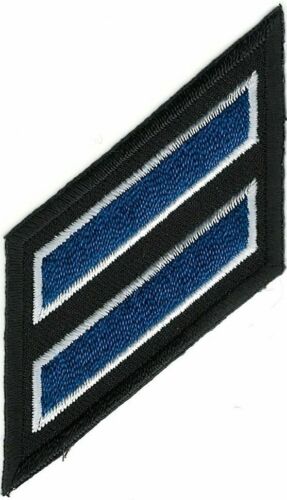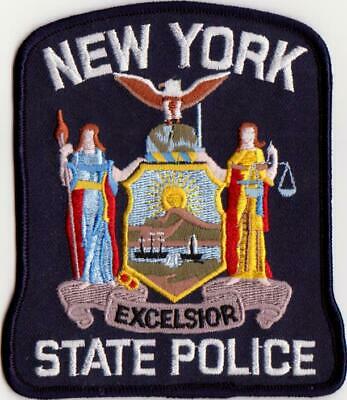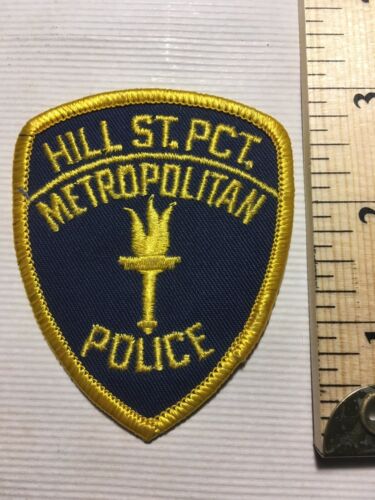-40%
GEMSCO NOS PDNY PATCH - PHUN POLICE ENVIROMENTAL PROTECTION NY - VINTAGE vM3
$ 2.08
- Description
- Size Guide
Description
NEPP&B.CoPATCH PHUN
COLLECTOR'S CORNER 101
Norm had a suggestion from a customer to offer some
"Gemsco"
New Old Stock patches for those young and old just starting out with
patch
collecting. Perfect for both
beginners
and seasoned collectors
looking for
an affordable assortment of choices.
But Make No Mistake, Norm Pledges . . .
Most PATCHES
we offer
are old school machine embroidered (
single hand fabrication or by a
Schiffli
embroidery
machine
) with natural fibers. Most have machine hand
merrowed
edges, the "
tailor's tail
"
intact (
rely on photo
) or were hand cut with die, mallet, on wax board. Many of our items are dated by manufacturing material and method and / or production paperwork if available.
There is nothing wrong with reproductions, they make great collection "place holders" . . .
we're here when you want to trade-up
.
. . . Same quality and service that N.E. Patch, Bin & Buckle offers.
This item was offered by now-defunct famous military, police fire, municipal, fraternal, club, and industry patch, pin, badge & buckle supplier
GEMSCO
General
Embroidery Military Supply Company - since 1881 -
- NOS
- EMBROIDERED PATCH -
Vintage -
In most cases this patch was an official issue patch in a size
that was used on a regulation "baseball" cap that replaced
the dress uniform hat with Shield attached.
-VERSION vM3 -
- PDNY - DEP OFFICER
NEW YORK CITY
ENVIRONMENTAL PROTECTION
City of New York Police Department
Vintage high quality item - Size: 2 1/2" X 3" - Shape: Shield
(see photo)
- Gauze Back - Merrowed Edge - Tailor's "Tail"
At first glance some patches we offer look exactly alike, so be sure to
take
a look
at the
photo of the back of the item. The back of the patch can
sometimes
tell you a lot
about the
patch . . . its' age, method of fabrication,
and
if it is sew-on or iron-on.
Also you may
notice
a quarter placed
on
the back of the patch, which is to
make it easy to size it up.
Finally, a question we frequently are asked is:
"Why are some patches that are very much alike, so much more costly than others/"
The simple answer is likely basic economics - SUPPLY and DEMAND.
On the
SUPPLY
side one must consider age of patch, condition
of the patch,
how many
were made in that era, and how
many still exist, for starters.
On the
DEMAND
side, it simply comes down to what most people want to
collect.
Police (law enforcement), Fire (rescue & ems), and Military
(army, navy,
air-force & marine corps) all seem to
have a
universal following,
BUT there
are growing
trends as
broad as
collectors'
favorite & specialty interests.
Of course DEMAND can be filled with more SUPPLY (production) of NEW patches,
which gets back to
SCARCITY
(the ability to find that "one" patch) . . .
Supply of any "one" patch of a certain age, style and condition.
You are purchasing described item only - photo staging
not
included
Photographs are considered part of the listing description.
Please contact us with any questions you may have.
As a condition of sale
, the purchaser confirms that the obsolete police, sheriff, fire, rescue
memorabilia and other similar patches are purchased for legitimate purpose of collecting,
display, theatrical production, memento;
or the lawful dealing in police, sheriff, fire,
rescue,
state,
municipal, fraternal, education, commerce and associated patches
and other memorabilia.
ITEM SHIPS VIA USPS 1ST CLASS
ALL ITEMS PURCHASED WILL SHIP THE FRIDAY AFTER COMPLETED SALE
INSURANCE, TRACKING, AND DELIVERY CONFIRMATION ONLY AS SPECIFIED IN LISTING
WE SHIP ONLY TO THE UNITED STATES & US TERRITORIES
We have many items to sell so please check back regularly.
We have been on Ebay for over 15 years with strong positive rating.
This patch meets eBay's regulations.
This patch is obsolete and is strictly for collecting.
This patch has no police or law enforcement authority.
Sales of this item are in full compliance with United States Federal Law: 18 USC § 716 et seq:
Whomever
:
(1)
knowingly transfers, transports, or receives, in interstate or foreign commerce, a counterfeit official insignia or uniform;
(2)
knowingly transfers, in interstate or foreign commerce, a genuine official insignia or uniform to an individual, knowing that such individual is not authorized to possess it under the law of the place in which the badge is the official official-insignia or uniform;
(3)
knowingly receives a genuine official insignia or uniform in a transfer prohibited by paragraph (2); or
(4)
being a person not authorized to possess a genuine official insignia or uniform under the law of the place in which the badge is the official ?insignia or uniform, knowingly transports that badge in interstate or foreign commerce, shall be fined under this title or imprisoned not more than 6 months, or both.
(b)
It is a defense to a prosecution under this section that the insignia or uniform is other than a counterfeit insignia or uniform
and is not used to mislead or deceive, or is used or is intended to be used exclusively?
(1)
as a memento, or in a collection or exhibit
;
(2)
for decorative purposes;
(3)
for a dramatic presentation, such as a theatrical, film, or television production; or
(4)
for any other recreational purpose.
(c) As used in this section?
(1)
the term ?genuine police badge? means an official badge issued by public authority to identify
an individual as a law enforcement officer having police powers;
(2)
the term ?counterfeit police badge? means an item that so resembles a police badge that it would deceive an ordinary individual into believing it was a genuine police badge; and?
(3)
the term ?official insignia or uniform? means an article of distinctive clothing or insignia, including a badge, emblem or identification card, that is an indicium of the authority of a public employee;
(4)
the term ?public employee? means any officer or employee of the Federal Government or of a State or local government; and
(5)
the term ?uniform? means distinctive clothing or other items of dress, whether real or counterfeit, worn during the performance of official duties and which identifies the wearer as a public agency employee.
(d
)
It is a defense to a prosecution under this section that the official insignia or
uniform is not used or intended to be used to mislead or deceive, or is a counterfeit insignia
or uniform
and is used or is intended to be used exclusively?
(1)
for a dramatic presentation, such as a theatrical, film, or television production; or
(2)
for legitimate law enforcement purposes.
__________________________________________________________________
A. The Use of Another's Trademark In A Descriptive Sense
It is a basic principle marking an outer boundary of the trademark monopoly that, while trademark rights may be acquired in a word, symbol or device, acquisition of those rights does not prevent others from using the word, symbol or devise in good faith in its descriptive sense, and not as a trademark. ?This principle is of great importance because it protects the right of society at large to use words or images in their primary descriptive sense, as against the claims of a trademark owner to exclusivity.?
Car-Freshner Corp. v. S.C. Johnson & Son, Inc., 70 F.3d 267, 269 (2d Cir. 1995)
; see Champion Spark Plug Co. v. Sanders, 331 U.S. 125 (1947) (registering proper noun as trademark does not withdraw it from language, nor reduce it to exclusive possession of registrant). To come within this fair use defense a person must make use of the other party's trademark (i) other than as a mark, (ii) in a descriptive sense, and (iii) in good faith. See
15 U.S.C. §1115(b)(4)
.
B. Reference to the Owner of the Mark or the Owner's Goods or Services
Another species of the fair use defense is the use of a mark when referring to the owner of a mark or the owner's goods or services. Once again, this defense is only available if the unauthorized user is not using the term for purposes of source identification and the use does not imply sponsorship or endorsement by the trademark owner. Obviously, a great deal of useful social and commercial dialogue would be all but impossible if speakers were under threat of an infringement lawsuit every time they made reference to a person, company or product by using its trademarks.
In
New Kids on the Block v. North American Pub., Inc., 971 F2d 302 (9th Cir. 1992),
the Ninth Circuit affirmed summary judgment in favor of the defendant newspapers which had used the trademarked name of the band ?New Kids on the Block? to refer to the band in polls it conducted for the purpose of stimulating newspaper sales. The Court referred to a ?class of cases where the use of the trademark does not attempt to capitalize on consumer confusion or to appropriate the cachet of one product for a different one,? noting that ?[s]uch nominative use of a mark ? where the only word reasonably available to describe a particular thing is pressed into service ? lies outside the strictures of trademark law: The Ninth Circuit stated that a commercial user is entitled to a nominative fair use defense if the user meets the following three requirements: (i) the product or service in issue must not be readily identifiable without reference to the mark; (ii) only so much of the mark may be used as is reasonably necessary to identify the product or service; and (iii) the user must not do anything to imply sponsorship or endorsement by the trademark owner.
New Kids on the Block, 971 F2d at 308
.
C. The First
Sale
Doctrine
The unauthorized use of another's trademark is also permitted under the ?first sale? doctrine. Under this doctrine a business that resells genuine, non-adulterated goods bearing a true mark cannot be held liable for trademark infringement, even if the distributor had no authority to do so from the actual trademark owner. See
Polymer Technology Corp. v. Mimran, 975 F.2d 58 (2d Cir. 1992)
. ?After the first sale, the brandholder's control is deemed exhausted [and d]own-the-line retailers are free to display and advertise the branded goods. Secondhand dealers may advertise the branded merchandise for resale in competition with the sales of the markholder . . . .?
Osawa & Co. v. B&H Photo, 589 F.Supp. 1163 (S.D.N.Y. 1984)
.
THANKS FOR LOOKING HAVE FUN BUYING or BIDDING!











